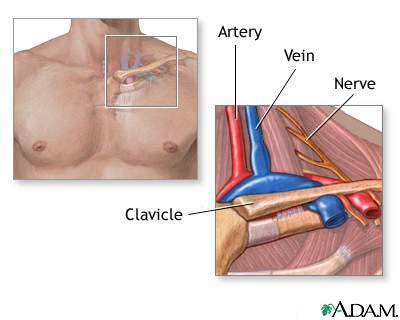Treatment
Physical therapy helps strengthen the shoulder muscles, improve range of motion, and promote better posture. Treatment may also include pain medication.
Surgery may be recommended if physical therapy and changes in activity do not improve your symptoms. Types of procedures that might be performed include:
- An extra rib is removed and certain muscles are cut.
- A section of the first rib is removed to release pressure in the area.
- Bypass surgery is done to reroute blood around the compression or remove the area that is causing the symptoms.
Your doctor may also suggest other alternatives, including angioplasty.
Prognosis (Expectations)
Having the fibrous band removed may eliminate symptoms if patients are selected carefully. Surgery can be successful in 50% to 80% of patients. Conservative approaches using physical therapy are helpful for many patients.
Complications
Complications can occur with any surgery and relate to the type of procedure and anesthesia used.
Damage to nerves or blood vessels may occur during surgery. This could lead to weakness of the arm muscles, or weakness of the muscles that help control the diaphragm when you breathe.
Pictures & Images
Thoracic outlet anatomy
-
Thoracic outlet syndrome: Overview, Causes
-
Thoracic outlet syndrome: Symptoms & Signs, Diagnosis & Tests
-
Thoracic outlet syndrome: Treatment
Review Date : 1/12/2009
Reviewed By : Robert A. Cowles, MD, Assistant Professor of Surgery, Columbia University College of Physicians and Surgeons, New York, NY. Review provided by VeriMed Healthcare Network. Also reviewed by David Zieve, MD, MHA, Medical Director, A.D.A.M., Inc.
